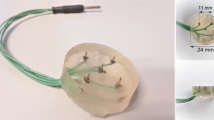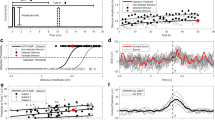Abstract
Background
We describe a new method to study the sensibility of the nipple-areola complex of the breast with faradic electricity delivered through an electromyographic device used to monitor peripheral nerve conduction.
Methods
The objective results of faradic pulses (2–50 mA per pulse) delivered to the nipple-areola complex of the breast through a Nihon-Kohden II machine (Evoked potential/Electromyographs, Nihon-Kohden Co., Japan) were evaluated in normal volunteers to get a basal measure that was defined by the patient as “a soft electric discharge.” The measures were recorded and their output discharges averaged (at least 5 to each complex).
Results
Twenty-eight volunteers with normal breasts, 28 patients with breast hypertrophy before and after breast reduction, and 28 patients before and after breast augmentation were studied. The faradic pulses were perceived from 1.5 to 3.5 mA in the areola and from 3 to 5.5 mA in the nipple in the control group and from 4.5 to 7.0 mA in the areola and from 6.5 to 9.5 mA in the nipple in the breast hypertrophy group with no significant changes before and after surgery. In the breast augmentation group the faradic pulses were very similar to the volunteers that had normal breasts, but 13 months after breast augmentation with silicone gel prosthesis, a difference was found because all the patients had a higher threshold and three cases had lost sensibility of the nipple-areola complex.
Conclusion
In normal breasts the areola had a lower threshold for faradic pulses compared to the nipple. Hypertrophic breasts had a higher threshold to the faradic stimulation than normal subjects in the pre- and postoperative period. Hypoplastic breasts before breast augmentation had a perception threshold similar to that of the normal volunteers but after breast augmentation this perception was much higher.





Similar content being viewed by others
References
Dellon ES, Mourey R, Dellon AL (1992) Human pressure perception values for constant and moving one- and two-point discrimination. Plast Reconstr Surg 90:112–117
Tairych GV, Kuzbari R, Rigel S, Todoroff BP, Schneider B, Deutinger M (1998) Normal cutaneous sensibility of the breast. Plast Reconstr Surg 102:701–704
Terzis JK, Vincent MP, Wilkins LM, Rutledge K, Deane LM (1987) Breast sensibility: a neurophysiological appraisal in the normal breast. Ann Plast Surg 19:318–322
Dellon ES, Crone S, Mourey R, Dellon AL (1993) Comparison of the Semmes-Weinstein monofilaments with the pressure specifying sensory device. Restor Neurol Neurosci 5:323–329
Dellon AL (1983) The vibrometer. Plast Reconstr Surg 71:427–431
Mofid MM, Dellon AL, Elias JJ, Nahabedian MY (2002) Quantitation of breast sensibility following reduction mammaplasty: a comparison of inferior and medial pedicle techniques. Plast Reconstr Surg 109:2283–2288
Santanelli F, Paolini G, Bittarelli D, Nofroni I (2007) Computer-assisted evaluation of nipple-areola complex sensibility in macromastia and following superolateral pedicle reduction mammaplasty: a statistical analysis. Plast Reconstr Surg 119:1679–1683
DelVecchyo C, Caloca J Jr, Caloca J, Gomez-Jauregui J (2004) Evaluation of breast sensibility using dermatomal somatosensory evoked potentials. Plast Reconstr Surg 113:1975–1983
Farina MA, Newby BG, Alani HM (1980) Innervation of the nipple-areola complex. Plast Reconstr Surg 66:497–501
Jaspars JJ, Posma AN, van Immerseel AA, Gittenberger-de Groot AC (1997) The cutaneous innervation of the female breast and nipple-areola complex: implications for surgery. Br J Plast Surg 50:249–259
Sarhadi NS, Shaw Dunn J, Lee FD, Soutar DS (1996) An anatomical study of the nerve supply of the breast, including the nipple and areola. Br J Plast Surg 49:156–164
Schlenz I, Kuzbari R, Gruber H, Holle J (2000) The sensitivity of the nipple-areola complex: an anatomic study. Plast Reconstr Surg 105:905–909
Freilinger G, Holle J, Sulzgruber SC (1978) Distribution of motor and sensory fibers in the intercostal nerves. Significance in reconstructive surgery. Plast Reconstr Surg 62:240–244
Craig RD, Sykes PA (1970) Nipple sensitivity following reduction mammaplasty. Br J Plast Surg 23:165–172
Dellon AL (2003) Invited discussion: sensibility of the breast following reduction mammaplasty. Ann Plast Surg 51:6–9
Ferreira MC, Costa MP, Cunha MS, Sakae E, Fels KW (2003) Sensibility of the breast after reduction mammaplasty. Ann Plast Surg 51:1–5
Godwin Y, Valassiadou K, Lewis S, Denley H (2004) Investigation into the possible cause of subjective decreased sensory perception in the nipple-areola complex of women with macromastia. Plast Reconstr Surg 113:1598–1606
Gonzalez F, Brown FE, Gold ME, Walton RL, Shafer B (1993) Preoperative and postoperative nipple-areola sensibility in patients undergoing reduction mammaplasty. Plast Reconstr Surg 92:809–814. discussion 815–808
Greuse M, Hamdi M, DeMey A (2001) Breast sensitivity after vertical mammaplasty. Plast Reconstr Surg 107:970–976
Hamdi M, Blondeel P, Van de Sijpe K, Van Landuyt K, Monstrey S (2003) Evaluation of nipple-areola complex sensitivity after the latero-central glandular pedicle technique in breast reduction. Br J Plast Surg 56:360–364
Hamdi M, Greuse M, De Mey A, Webster MH (2001) A prospective quantitative comparison of breast sensation after superior and inferior pedicle mammaplasty. Br J Plast Surg 54:39–42
Kuzbari R, Schlenz I (2007) Reduction mammaplasty and sensitivity of the nipple-areola complex: sensuality versus sexuality? Ann Plast Surg 58:3–11
Schlenz I, Rigel S, Schemper M, Kuzbari R (2005) Alteration of nipple and areola sensitivity by reduction mammaplasty: a prospective comparison of five techniques. Plast Reconstr Surg 115:743–751. discussion 752–744
Slezak S, Dellon AL (1993) Quantitation of sensibility in gigantomastia and alteration following reduction mammaplasty. Plast Reconstr Surg 91:1265–1269
Wechselberger G, Stoss S, Schoeller T, Oehlbauer M, Piza-Katzer H (2001) An analysis of breast sensation following inferior pedicle mammaplasty and the effect of the volume of resected tissue. Aesthetic Plast Surg 25:443–446
Courtiss EH, Goldwyn RM (1976) Breast sensation before and after plastic surgery. Plast Reconstr Surg 58:1–13
Banbury J, Yetman R, Lucas A, Papay F, Graves K, Zins JE (2004) Prospective analysis of the outcome of subpectoral breast augmentation: sensory changes, muscle function, and body image. Plast Reconstr Surg 113:701–707. discussion 708–711
Nahabedian MY (2006) Effect of augmentation mammaplasty on breast sensation: discussion. Plast Reconstr Surg 117:84–85
Okwueze MI, Spear ME, Zwyghuizen AM, Braun SA, Ajmal N, Nanney LB, Hagan KF, Wolfort SF, Shack RB (2006) Effect of augmentation mammaplasty on breast sensation. Plast Reconstr Surg 117:73–83. discussion 84–75
Pitanguy I, Vaena M, Radwanski HN, Nunes D, Vargas AF (2007) Relative implant volume and sensibility alterations after breast augmentation. Aesthetic Plast Surg 31:238–243
Author information
Authors and Affiliations
Corresponding author
Additional information
This study received the Scientific Exhibit Award at the ASAPS/ASERF Annual Meeting in Vancouver, British Columbia, Canada, 2005.
Rights and permissions
About this article
Cite this article
Prado, A., Andrades, P., Benitez, S. et al. Areola-Nipple Perception Threshold to Faradic Electricity: A New Measure of Sensibility of the Breasts. Aesth Plast Surg 32, 748–752 (2008). https://doi.org/10.1007/s00266-008-9148-4
Received:
Accepted:
Published:
Issue Date:
DOI: https://doi.org/10.1007/s00266-008-9148-4




